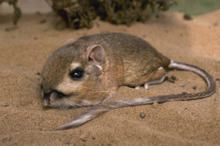Genus Dipodomys Higher classification Kangaroo rat | Phylum Chordata Scientific name Dipodomys heermanni Rank Species | |
 | ||
Similar Kangaroo rat, Fresno kangaroo rat, Narrow‑faced kangaroo rat, Mammal, Rodent | ||
Heermann's kangaroo rat (Dipodomys heermanni) is a species of rodent in the family Heteromyidae.
Contents
Distribution
Dipodomys heermanni is endemic to California in the United States. The range is limited as well, extending north to south from Lake Tahoe to Point Conception, and east to west from the Sierra Nevada mountain range to the Pacific Ocean. However, even with this small home range, the Heermann's kangaroo rat is listed as a species of least concern according to the IUCN.
Home Range
With all the interconnected surface runways within a community composed of individual Heermann's kangaroo rats, it is incredibly difficult to narrow down individual home ranges. Because of this difficulty in distinguishing home ranges, the estimated values fluctuate greatly. In one study, more than half of all recaptured rats were found within 30.5 meters of their first capture. Home ranges can be very different from each other and can consist of differing levels of vegetation. Most common areas are on coastal plains or ridges with shallow soil.
Population Density
Population densities experiences many ups and downs and have been shown to range from 2-30 kangaroo rats per hectare. There seems to be no way of predicting whether or not emigration has anything to do with these large fluctuations in population density. Typically, it is only the larger rats that take part in emigration, and females have been shown to exhibit this behavior more often than males.
Ecology
Heermann's kangaroo rats are burrowing animals, and the rats manipulate the tunnels already made by other burrowing animals to make their own. The extent of the burrowing behavior highly depends on the type of soil present in their home range. Heermann's kangaroo rats are granivores, which is the most important part of their diet. The rats also are herbivores, and especially during seasons of winter and spring. Most of the plant material near the burrows in their home ranges are utilized. Heermann's kangaroo rat achieve necessary water consumption from seeds and dew from the plant material in their diet. The rats will only drink from a puddle or direct water source if water intake isn't achieved for several weeks. If the dry food matter increases and humidity is decreased, the mean daily activity of the rats drastically declines.
Behavior
The kangaroo rat does not hibernate. Instead, it remains more or less active during the year depending on time of day. Living in a burrow for the majority of the day and typically coming out only at night, The Heermann's kangaroo rat lives a solitary life. However, experiments have shown that sociality does alter the rat's behaviors and that the rat does indeed have some ability to form generalized sociality. Sociality is measured by willingness to participate in social interactions. Kangaroo rats exhibit their willingness to interact with each other with a characteristic foot drumming, where increased foot drumming was associated with unwillingness to socialize and the absence of foot drumming was associated with willingness to socialize. High rates of interspecies competition has been observed; however, intraspecies competition between Heermann's kangaroo rats has not been directly observed.
Reproduction
Heermann's kangaroo rat rarely show increase levels of sexual behavior. Copulation is rather quick, and typically only lasts a couple seconds. If the animals are caged, the rats show no increase in sexual behavior. Females rats will even show aggression if her genitalia are swollen and enlarged. During labor, the female rat will assist the delivery of the young with her front paws. The female Heermann's kangaroo rats also fondle her babies after birth with fondling, smelling, and licking.
